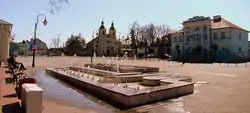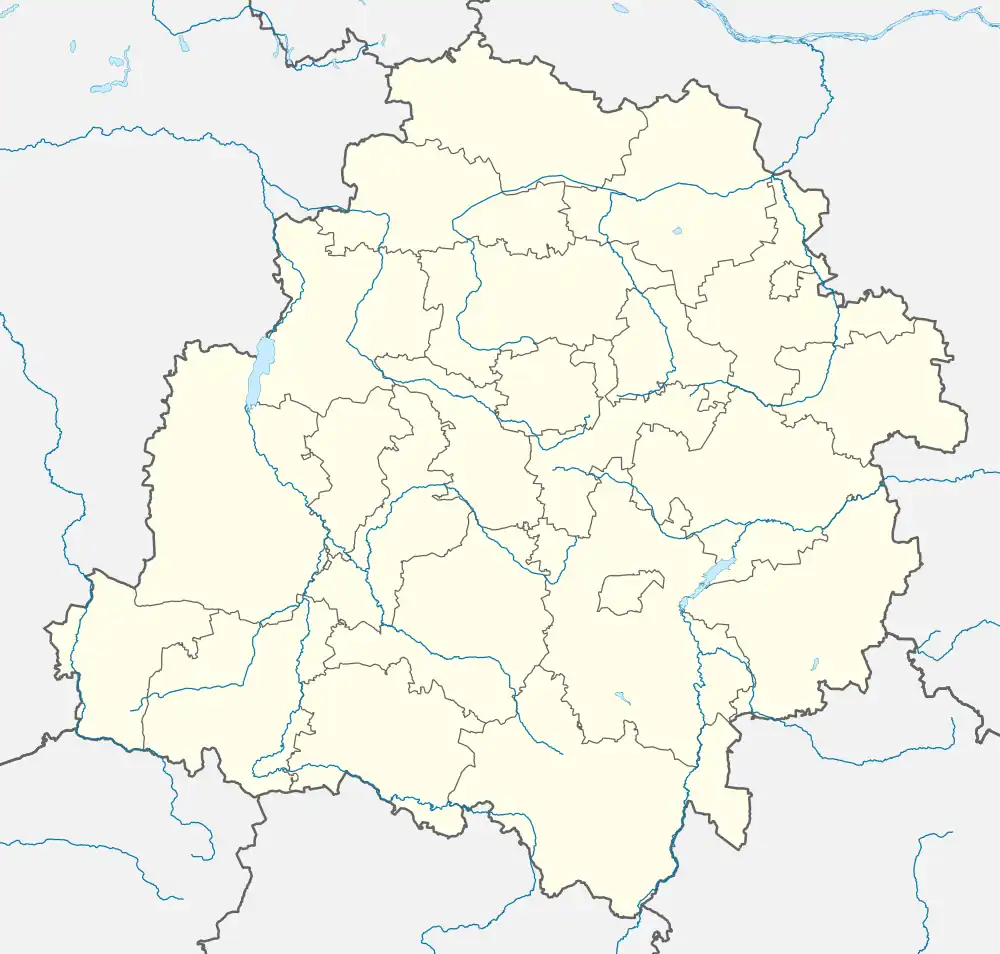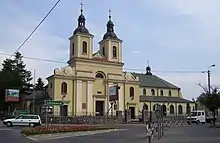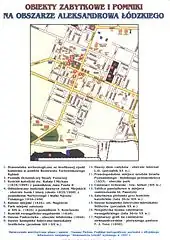Aleksandrów Łódzki | |
|---|---|
Town | |
 Kościuszko Square in Aleksandrów Łódzki | |
 Flag  Coat of arms | |
 Aleksandrów Łódzki  Aleksandrów Łódzki | |
| Coordinates: 51°49′10″N 19°18′14″E / 51.81944°N 19.30389°E | |
| Country | |
| Voivodeship | |
| County | Zgierz |
| Gmina | Aleksandrów Łódzki |
| Established | 19th century |
| Town rights | 1822–1869, 1924 |
| Government | |
| • Mayor | Jacek Lipiński (PO) |
| Area | |
| • Total | 13.82 km2 (5.34 sq mi) |
| Elevation | 206 m (676 ft) |
| Population | |
| • Total | 22,160 |
| • Density | 1,603/km2 (4,150/sq mi) |
| Time zone | UTC+1 (CET) |
| • Summer (DST) | UTC+2 (CEST) |
| Postal codes[5] | 95-069, 95-070 |
| Area code[6] | +48 42 |
| Number plates[7] | EZG |
| Website | http://aleksandrow-lodzki.pl |
Aleksandrów Łódzki ([alɛkˈsandruf ˈwut͡skʲi] ⓘ; German: 1943–45 Wirkheim) is a town in Zgierz County, Łódź Voivodeship, Poland. It is a part of the Łódź agglomeration. Aleksandrów Łódzki has an area of 13.82 square kilometres (5.34 square miles),[2] and as of June 2022 it has a population of 22,160.[3]
History

The village was founded in 1816 by Rafał Bratoszewski. In 1820, Rajmund Rembieliński called Aleksandrów "one of the better towns in Poland." Bernard von Schuttenbach was the author of the town planning project. In order to gain sympathy of the government, Bratoszewski called the town after the then ruling Russian Emperor Alexander I Romanov. This resulted in Aleksandrów gaining the town rights in 1822. After Bratoszewski died in 1824, the Kossowski family took over the town.
After 1832, the town began to fall back, economically overwhelmed by the nearby towns of Pabianice, Zgierz and Łódź. In the late 19th century and early 20th century, many knitting companies were founded in Aleksandrów, so it is called the cradle of the Polish stocking industry and also gained the nickname "Sock-city" among the citizens. This trade is still the main one today. In 1910, the town gained a tram connection with Łódź, which was discontinued in 1991.
| Year | Pop. | ±% |
|---|---|---|
| 1921 | 8,236 | — |
| 1931 | 11,554 | +40.3% |
| 2010 | 20,809 | +80.1% |
| Source: [8][9] | ||
Historically, Aleksandrów was a town of multiple cultures and religions. There were Protestant descendants of German knitters, Jews who were in trade and Catholic Poles who mainly worked as craftsmen and in factories. The Jewish population in 1900 was 1,673.[10] For the Jewish, Aleksandrów was an important religious centre - the seat of Hasidic tzadikim of the Aleksander dynasty founded by Rabbi Yechiel Dancyger (1828–1894). It was also where Rabbi Chanokh Heynekh HaKohen Levin, the second Rebbe of the Ger Hasidim held court until his death in Aleksandrów in 1870.
In 1869, Aleksandrów lost its town rights. These rights were regained in 1924 in the newly reborn Poland.
Currently, it is the seat of the Aleksandrów Łódzki county. In September 2006, the first International Convention of Aleksandrów citizens was held.
Economy
Currently, there are 2,623 registered companies in Aleksandrów. The textile industry constitutes 38% of the economy, trade - 24%, vehicle mechanics and transport - 5%, and other - 33%.
Tourism

The oldest monuments of Aleksandrów include:
- St. Rafael and Michael Catholic church - built between 1816 and 1818 and rebuilt three times (1922–1926 - two aisles added; 1933–1935 - two towers added; 1993 - added a second nave with its own altar). Under the church lies buried Rafał Bratoszewski - founder of Aleksandrów
- Evangelic church - built in 1828 by pastor Fryderyk Jerzy Tuve
- Jatki - rebuilt in 1998, formerly a place for butchers and bakers to sell their goods; now a part of the town hall
- The town hall - built in 1824. It still serves its function today
- The library - originally the house of a pastor built in 1848
- The oldest grave - dating from 1830, the place of burial for Fryderyk Jerzy Tuve. There is also a Jewish cemetery in the northern part of the town with graves of Hasidic tzadiks
- The municipal park - an English-styled garden founded by Rafał Bratoszewski in 1824
- Weaver houses - long wooden houses of the first settlers from the first half of the 19th century
- Albert Stiller's villa and factory - built in 1908
- Dormitory of Nicolaus Copernicus High School, a former mansion of Hasidic tzadikim from Danziger dynasty, built in 1935
Sports
- Towarzystwo Sportowe Sokół-Syguła. Founded in 1998, with soccer and karate sections. Stanisław Syguła is the chairman and main sponsor of the club
- MULKS Aleksandrów - established in 2004 - youth soccer
- MKS Aleksandrów - track and field athletics
- UKS Jedynka - volleyball
- Sporting events
- Józef Jaworski track and field memorial - held annually since 1983
Local media
- 40 i cztery (title is a reference to the tram line number 44 that connected Aleksandrów with Łódź) monthly bulletin issued by the local commune. It has appeared since 8 December 1991, formerly as a biweekly. Current editor-in-chief - Dorota Bełdowska-Zemła
- Alternatywy 44 monthly bulletin issued by the Aleksandrów Association of Entrepreneurs 2000. Current editor-in-chief - Tomasz Dominowski
- Wiadomości aleksandrowskie bulletin of St. by Rafael and Michael parish initiated by Rev. dr Norbert Rucki
- Aleksandrów wczoraj i dziś [Aleksandrów yesterday and today] - a yearly publication appearing since 1983 on behalf of Friends of Aleksandrów Association. Current editor-in-chief - Zenon Kozanecki
- Gazeta Matusiaka, independent newspaper issued by Grzegorz Matusiak in 1992–2004
- TELETOP TV
International relations
Twin towns – sister cities
Aleksandrów Łódzki is twinned with:[11]
 Krāslava, Latvia
Krāslava, Latvia Ossiach, Austria
Ossiach, Austria Puget-Ville, France
Puget-Ville, France
See also
References
- ↑ "Burmistrz" [Mayor]. aleksandrowlodzki.bip.net.pl (in Polish). Urząd Miejski w Aleksandrowie Łódzkim. Retrieved 26 November 2022.
- 1 2 "Local Data Bank". bdl.stat.gov.pl. Statistics Poland. Retrieved 23 February 2023. Category K1, group G441, subgroup P1410. Data for territorial unit 1020044.
- 1 2 "Local Data Bank". bdl.stat.gov.pl. Statistics Poland. Retrieved 23 February 2023. Category K3, group G7, subgroup P1336. Data for territorial unit 1020044.
- ↑ "Local Data Bank". bdl.stat.gov.pl. Statistics Poland. Retrieved 23 February 2023. Category K3, subgroup G7, group P2425. Data for territorial unit 1020044.
- ↑ "Oficjalny Spis Pocztowych Numerów Adresowych" (PDF). poczta-polska.pl (in Polish). Poczta Polska. pp. 4, 1655. Retrieved 15 February 2023.
- ↑ Rozporządzenie Ministra Administracji i Cyfryzacji z dnia 30 października 2013 r. w sprawie planu numeracji krajowej dla publicznych sieci telekomunikacyjnych, w których świadczone są publicznie dostępne usługi telefoniczne, Dz. U. z 2013 r. poz. 1281 (2013-10-30)
- ↑ Rozporządzenie Ministra Infrastruktury z dnia 31 sierpnia 2022 r. w sprawie rejestracji i oznaczania pojazdów, wymagań dla tablic rejestracyjnych oraz wzorów innych dokumentów związanych z rejestracją pojazdów, Dz. U. z 2022 r. poz. 1847 (2022-08-31)
- ↑ Wiadomości Statystyczne Głównego Urzędu Statystycznego (in Polish). Vol. X. Warszawa: Główny Urząd Statystyczny. 1932. p. 140.
- ↑ Stan i struktura ludności oraz ruch naturalny w przekroju terytorialnym w 2010 r. (PDF) (in Polish). Warszawa: Główny Urząd Statystyczny. 2011. p. 66. Archived from the original (PDF) on 13 November 2011.
- ↑ "Aleksandrów Łódzki, Poland". www.jewishgen.org. JewishGen. Retrieved 26 November 2022.
- ↑ "Miasta partnerskie" [Partner towns]. oldwww.aleksandrow.lodzki.pl (in Polish). Urząd Miejski w Aleksandrowie Łódzkim. Retrieved 26 November 2022.
External links
- Official website (in Polish)
- Jewish community of Aleksandrów Łódzki on Virtual Shtetl